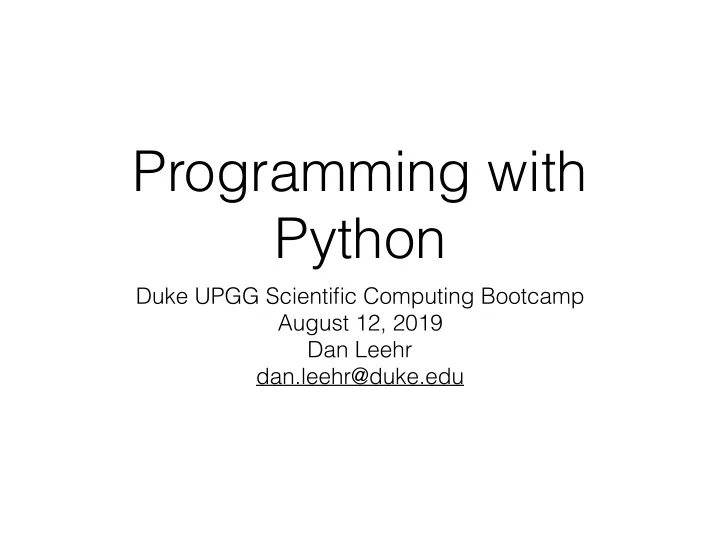

Programming with Python Duke UPGG Scientific Computing Bootcamp August 12, 2019 Dan Leehr dan.leehr@duke.edu
What book should I read? How many books about riding a bike did you read?
“You can be a scientist in the science of bike ride mechanics and it still won’t help you one bit to do the actual thing.” http://twonontechies.com/bicycles-can-help-you-learn-programming/
Why Python? • We have to use something • It’s free, well-documented, and runs everywhere • Large community among scientists • Relatively easy to pick up, but programming is hard !
Goals • Write and run programs in Python • Understand basic data types and functions • Work with files and libraries • Know where to look for more help I know, I’ll use Python !
Download • Download the python-fasta.zip file from the course website - Syllabus . • Unzip it and place on your Desktop: python-fasta/ ae.fa ls_orchid.fasta
1. Open Anaconda Navigator (installed with Anaconda) 2. Click to launch Jupyter Notebook
Begin Jupyter Notebook
Data Types • Numeric: • Integer: 1, 76, 400 • Float: -1.2, 0.5, 3.1415926 (Use a decimal point) • Boolean: True, False • Text: • Strings: ‘ACTGACAG' (Wrap in quotes)
Strings • Strings can be created with quotes or double quotes: name = 'Daniel' • Access individual letters as strings with [] (starting at 0) name[0] # D name[1] # a • Check if a letter exists in a string 'a' in name # True 'a' not in name # False
Variables • Assign variables with equals x = 3 • Access variables by name print x # 3 • Variables work like sticky notes, they’re just a label on top of a value
What do we know? • Our sequence is a string, in seq10 • Strings are sequences of characters, each at a numbered position (starting from 0) • We can extract characters as strings with square brackets [ ] • We can combine strings together with +
Exercise: Reverse • Write some code that reverses the sequence in seq. • It should 1. Create an empty string variable rev rev = '' 2. Loop over the items in seq , adding these to rev in reversed order 3. Print the contents of rev
Loops • Write a loop with for item in collection: for letter in word: print letter • Always put a colon at the end of the line, indented lines are run for every item in the collection
Complementing • We can loop over all the → A T bases in a sequence → C G • Each base has a complement that we should substitute: → T A • We can use a Dictionary to store this mapping. → G C
Dictionaries and Lists • Create dicts with {}, lists with [] nucs = {'A': 5, 'C': 4, 'T': 8} counts = [5,4,8] • Both accessed with [] - dicts by key, lists by index nucs['A'] # 5 counts[0] # 5 nucs['A'] = 3 # now 3 counts[0] = 3 # now 3
GC-content percentage • Calculated as (G + C) / (A + T + G + C) • Create a GC count variable and an ATGC count variable • Loop over each base in the sequence • If G, add 1 to GC count • If C add 1 to GC count • For everything, add 1 to ATGC count
Conditionals # Test c1 for True or False if c1: print "c1 was True" # c1 was False, check c2 elif c2: print "c1 False but c2 True" # All checks False else: print "Both False"
Exercise: Functions bases = 'adenine cytosine guanine thymine' Write some code that: • Makes a list of these bases from the string • Uppercases the names (e.g. ['ADENINE', ...]) • Reverse s the order (e.g. ['THYMINE',...]) Hint: Use help(str) and help(list) to see what functions are available for strings and lists Bonus : Write a for loop to print the first letter of each (e.g. A, C, ...)
Exercise • Strings can be reversed with this special slicing notation: [::-1] s = 'abc' r = s[::-1] print(r) cba • Update reverse() function to use [::-1] instead of a loop. • Do we need to do anything to complement() ? What about reverse_complement()?
Functions • Calling functions: length = len('abc') • Defining functions: def double(x): return x * 2 • Composing functions: def reverse_complement(seq): return reverse(complement(seq)) • Avoid using global variables in functions
Exercise • Write a function, read_fasta(filename) that: • Takes 1 argument: filename • Reads the file line-by-line • Strips/combines the lines into one long line • Skips the line if it contains a > • Hint: if not 'i' in ‘team':
Reading files • Open a file with the open() function: f = open('ae.fa') • Loop over lines, and strip() each one for line in f: print line.strip() • Close with f.close()
Scripts • Put code in a file, give it the .py extension • Read command line-arguments from sys.argv: import sys print sys.argv[0] print sys.argv[1] $ python script.py hello script.py hello • Check the length of sys.argv to be helpful!
Recommend
More recommend